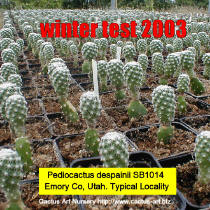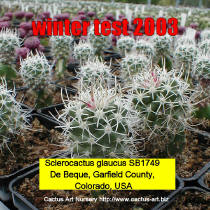International winter hardy cactus test
This
test has been possible thanks to the collaboration of cactus
impassioned, growers, collectors, clubs, botanical gardens and
researchers of all the world.
|
|
|
|
THE
PURPOSE OF THE TEST |
|
The
purpose of this great project is to verify
experimentally the outdoor resistance to
the cold of two plants grafted on a frost hardy
Opuntia compressa stock in different
nations and climates:
Pediocactus despainii SB1014 near San Rafael Swell Emory Co, Utah
from Typical Locality
Sclerocactus glaucus SB1749 De beque, Garfield County, Colorado, USA
|
| |
 |

 |
 |
|
|
winter_test_test_rules.htm |
Rule of the test
-
Each
participant received
the free plants (Two Pediocactus despainii and one
Sclerocactus glaucus) for the test and send: A photo
of its town, a photo of the local landscape and a
photo of the its own plant collection.
-
A page with the list of
the participants to the
project and the photos of the various places where the plants are
cultivated has been realized on this site, so everyone one may
know something about the environments where the tests are carried
out.
-
When possible further
information has been furnished: Altitude
of the place where the plants are cultivated, Locals minimum and
maximum temperatures, a brief description of the climate (rainy,
dry, etc.), the URL of the personal site of the participants (if
owned)
-
Each participant at the
arrival repotted the test plants with his usual soil mix and then
send a photo of the plants already planted in their pots. The
plants has been normally cultivated as usual for other
cacti in the personal way used by each participant!
Of the two Pediocactuses
one has been be protected
during the winter in the greenhouse with the other cactuses, the
other Pediocactus and the Sclerocactus instead has been left for
the whole winter outdoor in a sheltered place avoiding direct
rain.
-
During winter the minimum
temperatures has been collected and the results of the test has
been compared, and updated photos has been regularly added in each
personal page of the test. In spring 2004 and subsequently the
appearance and the state of health of the plants has been
verified.
|
|
A special
thanks to the people that have already agreed to this initiative
|
|